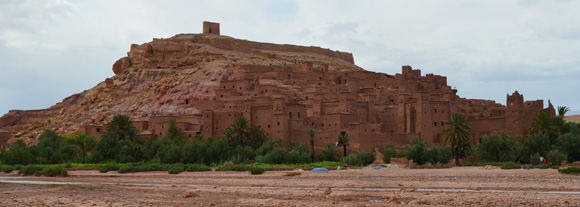 The road form Ouarzazate to Télouet passes through a natural setting of rare beauty with palm groves and verdant areas that owe their existence to the presence of adequate water, including the Ounila wadi. Along the road a series of casbahs can be seen in the distance, their buildings a rich earthy colour. These villages cluster around a strong fortress, an essential stopping point for the caravans travelling this route, but also the centre for small farming communities that, despite the difficulties presented by the terrain, were able to make use of such poor resources for their maintenance. An essential element for existence here are the wadis that flow mainly from the Atlas range, capable, when particular phenomena coincide with a rainfall, of swelling so much that they are difficult to ford and, where there is no bridge, can only be crossed on the back of a dromedary. On the banks of the wadis are small, flourishing oases, filled with lush date palms that not only provide edible fruit but with the shade of their leafy fronds also fulfil the important role of protecting other fruit trees and plots of vegetables and grain from the strength of the sun’s rays. in fact, grain, vegetables and fruit are the main produce of the intensive farming practised for centuries on this land by the inhabitants of the ksour, as is evident from the presence in many villages of typical, immense and majestic granary fortresses, known as ighrem, in many villages.
The road form Ouarzazate to Télouet passes through a natural setting of rare beauty with palm groves and verdant areas that owe their existence to the presence of adequate water, including the Ounila wadi. Along the road a series of casbahs can be seen in the distance, their buildings a rich earthy colour. These villages cluster around a strong fortress, an essential stopping point for the caravans travelling this route, but also the centre for small farming communities that, despite the difficulties presented by the terrain, were able to make use of such poor resources for their maintenance. An essential element for existence here are the wadis that flow mainly from the Atlas range, capable, when particular phenomena coincide with a rainfall, of swelling so much that they are difficult to ford and, where there is no bridge, can only be crossed on the back of a dromedary. On the banks of the wadis are small, flourishing oases, filled with lush date palms that not only provide edible fruit but with the shade of their leafy fronds also fulfil the important role of protecting other fruit trees and plots of vegetables and grain from the strength of the sun’s rays. in fact, grain, vegetables and fruit are the main produce of the intensive farming practised for centuries on this land by the inhabitants of the ksour, as is evident from the presence in many villages of typical, immense and majestic granary fortresses, known as ighrem, in many villages.
Among the numerous casbah and many ksour flanking the long road that crosses the valley, the desert extending on either side, is the magnificent settlement of AÏT Ben Haddou, a wonderful fortified village perched on high anda real architectural jewel built of beaten earth.It is, however, precisely this construction material that inevitably represents the greatest weakness of the buildings, being exceptionally subject to attrition by time and especially the weather as is all too easy to imagine.
CASBAH AÏT BEN HADDOU
this magnificent, earth-built fortified village became one of UNESCO’s World Heritage sites in December 1987. Situated on the top of a hill some 40 Kilometres to the north-west of Ouarzazate, it is so ‘photogenic’ that it has been used as the background for some memorable scenes in two film masterpieces – ‘Sodom and Gomorrah’ and ‘Lawrence of Arabia’ directed by David lean.
Tamdaght
Once the property of the powerful Glaoui family, this impressive casbah, although in a poor state of conservation, still stands majestically dominating a truly magnificent site. Originally the great earth-built villages, the ksour, were built by nomad families who wished to spend a certain period in a fixed location. Although the materials and methods used in their construction are of immense interest, they are also their real weak point. The buildings are exposed to heavy erosion by winds that carry sand with them, and by heavy and violent rain that , with the passing of time and without adequate protection, can reduce these monuments to their original element – the earth.